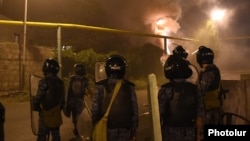The Armenian police said on Wednesday that they have been ordered to identify “civilians” that beat up journalists and protesters during the violent dispersal of a demonstration held last week in support of gunmen barricaded inside a Yerevan police compound.
The attacks took place as riot police forced hundreds of protesters to flee the city’s Sari Tagh neighborhood located just a few hundred meters from the compound.
Many protesters as well as at least 14 journalists were ambushed by a large group of men wielding sticks. Human rights activists have suggested that the attackers were plainclothes officers or government loyalists.
A police statement said that the national police chief, Vladimir Gasparian, has ordered his high-ranking subordinates to identify and track down “civilians who provoked clashes and assaulted participants of the gathering, journalists and police officers.”
The violence against the journalists, among them three RFE/RL employees, has been strongly condemned by Armenian and international press freedom groups.
The police used force against the Sari Tagh crowd on Friday shortly after being pelted with stones. The statement did not clarify whether law-enforcement authorities believe the stones were thrown by the same individuals who attacked protesters and journalists moments later.
The chief of Yerevan’s police department, Ashot Karapetian, and other police officials at the scene cited the stone throwing when they warned organizers of the protest to lead the angry crowd back to the city center.
They also pointed to Sari Tagh’s proximity to the scene of a standoff between security forces and the gunmen. The sounds of gunfire and explosions emanating from the seized police compound could be heard during the demonstration.
The police fired dozens of stun grenades and charged at the protesters after the organizers refused to obey their orders. At least 60 protesters were injured and hospitalized as a result of what the Armenian opposition and human rights activist have condemned as excessive force.
Many injuries were caused by stun grenade fragments. A 17-year-old man was struck in the eye and had it removed by doctors as a result.
Vartan Harutiunian, a veteran activist and Soviet-era dissident, called the violent dispersal “unnecessary and unjustified,” saying that the demonstration was peaceful. He accused the police of violating their own guidelines on the use of stun grenades and other “special means” of crowd control.
In a report on the Sari Tagh violence released earlier this week, the New York-based group Human Rights Watch (HRW) also criticized the police for firing such grenades “directly into crowds.” “Although the grenades are technically non-lethal, their fragmentation can foreseeably cause serious injuries in an indiscriminate manner, exposing non-violent protesters and on-lookers to grave harm,” it said.
Incidentally, two representatives of HRW met in Yerevan on Wednesday with Vahram Shahinian, the chief of Armenia’s Special Investigative Service (SIS), a law-enforcement body investigating both the attack on the police station and violence against journalists. Shahinian was quoted by his press office as assuring them that the SIS is conducting an “impartial, full and comprehensive inquiry.”
The police launched a separate “internal inquiry” on Monday.





